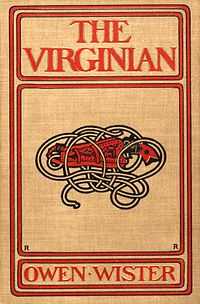The Virginian (novel)
|
First edition cover | |
| Author | Owen Wister |
|---|---|
| Original title | The Virginian |
| Country | United States |
| Language | English |
| Genre | Western |
| Publisher | Macmillan |
Publication date | 1902 |
| Media type | Print (hardback & paperback) |
| ISBN | NA |
| OCLC | 65699996 |
The Virginian (otherwise titled The Virginian: A Horseman of the Plains) is a 1902 novel set in the Wild West by the American author Owen Wister. It describes the life of a cowboy on a cattle ranch in Wyoming and was the first true western ever written, aside from short stories and pulp dime novels. The Virginian paved the way for many more westerns by such authors as Zane Grey, Louis L'Amour, and several others.
Fictional character
The Virginian is a ranch hand at the Sunk Creek Ranch, located outside of Medicine Bow, Wyoming. His nickname is Jeff and he is always referred to as the Virginian. He is described as a tall, dark, slim young giant, with a deep personality. At first, he is only a cowboy, but halfway through the book, he is signed on as the full-time foreman. He is the Judge's most trusted worker. Several times throughout the book, he is offered the chance to run down his enemy, Trampas, behind his back, but each time he refuses the temptation. It is made clear that he will not use his official position as foreman to crush any of his employees. One of the main plots is the Virginian's ongoing romance with the newly appointed schoolmarm of Medicine Bow, Miss Molly Stark Wood. Being from the East, she is not used to the wild West, and the Virginian is a perfect gentleman to her, intending to make her "love him before we get through."[1]
Plot summary

The novel begins with an unnamed narrator's arrival in Medicine Bow, Wyoming, from back East and his encounter with an impressively tall and handsome stranger. The stranger proves adept at roping horses, as well as facing down a gambler, Trampas, with a pistol and a gently threatening, "When you call me that, smile!" This stranger, known only as the Virginian, turns out to be the narrator's guide to Judge Henry's ranch in Sunk Creek, Wyoming. As the two travel the 263 miles to the ranch, the narrator, nicknamed the "tenderfoot" and the Virginian begin to come to know one another as the Tenderfoot slowly begins to understand the nature of life in the West, which is very different from what he expected. This meeting is the beginning of what becomes a deep lifelong friendship and the starting point of the narrator's recounting of key episodes in the life of the Virginian.
From that point onward, the novel revolves around the Virginian and the life he lives. As well as describing the Virginian's conflict with his enemy, Trampas, and his romance with the pretty schoolteacher, Molly Stark Wood, Wister weaves a tale of action, violence, hate, revenge, love and friendship. In one scene, the Virginian is forced to participate in the hanging of an admitted cattle thief, who had been his close friend. The hanging is represented as a necessary response to the government's corruption and lack of action, but the Virginian feels it to be a horrible duty. He is especially stricken by the bravery with which the thief faces his fate, and the heavy burden that the act places on his heart forms the emotional core of the story.
A fatal shootout resolves the ongoing conflict with Trampas, after five years of hate. The Virginian shoots Trampas in a gun battle and leaves to marry his young bride. The Virginian and Molly ride off together to spend a month in the mountains and then journey back East to Vermont[2] to meet her family. They were received a bit stiffly by the immediate Wood family, but warmly by Molly's great-aunt. The new couple return to Wyoming and the Virginian is made a partner of Judge Henry's ranch. The book ends noting that the Virginian became an important man in the territory with a happy family.
Film Adaptions
- The Virginian (1914 film) directed by Cecil B. DeMille, with Dustin Farnum
- The Virginian (1923 film) with Kenneth Harlan and Florence Vidor
- The Virginian (1929 film) with Gary Cooper and Walter Huston
- The Virginian (1946 film) with Joel McCrea and Brian Donlevy
- The Virginian (1962 - 1971 TV Series) with James Drury and Doug McClure
- The Virginian (2000) (TV movie) with Bill Pullman and Diane Lane
- The Virginian (2014) (Video) with Trace Adkins and Victoria Pratt
References
- Graulich, Melody; Tatum, Stephen. Reading the Virginian in the New West. Lincoln, Nebraska: University of Nebraska Press, 2003. ISBN 0-8032-7104-2
External links
| ||||||||||||||||||
| ||||||||||||||||||||

